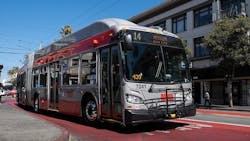SFMTA’s new way of generating prediction times
When the San Francisco Municipal Transportation Agency (SFMTA) implemented its Core Service Plan, which focused resources to 17 priority lines, the agency also transitioned its service operation from a schedule-based system to a headway system.
In doing this, SFMTA had to adjust how this information was processed by NextMuni to generate reliable arrival time predictions.
Up until now, if a Muni vehicle departed the terminal before its scheduled departure time, it would register on NextMuni as being on break and would not generate predictions, even though it was on its regular route. When SFMTA transitioned to a headway-based system, and as the buses experienced fewer delays on their routes, the agency started to see a lot of these vehicles depart before their scheduled times. The stopgap solution has been for a small team in the transit division to manually reassign these early departure vehicles within NextMuni, thereby allowing this system to generate predictions. Recently this team has been making about 300 such reassignments per day. This was neither efficient nor sustainable.
Working with the NextMuni vendor, SFMTA modified the prediction software to better handle this situation. When generating predictions, the software will now basically disregard any scheduled times and instead rely only on the vehicle’s location.
With this change, arrival time predictions will now only become available once a vehicle has left the terminal. What this means is that if a rider is waiting at a stop, especially stops near the beginning of the route, they may see “No Prediction Available” when they check either the bus shelter display (should one be available) or NextMuni’s online predictions. This will mean that a vehicle has not yet departed the terminal. In this case, please check either the website or that bus shelter’s display to see the frequency for that particular route. SFMTA’s website also has a live map which will show the location of each bus on the route, including those at the terminals that are not yet generating predictions. Simply use www.sfmta.com/the letter or number of the Muni route to check.
While this is not ideal, SFMTA says its other option was to make no change and have vehicles operating in service without generating predictions at all. The current changes will make sure most vehicles have predictions most of the time. Another benefit of this change will be that prediction times will now only reflect an actual vehicle that is in service, thus eliminating the dreaded “ghost bus,” which has been the bane of many transit riders, says the agency.
SFMTA’s team continually reviews the performance of its prediction system and suggests changes when they believe it will result in more accurate information to riders. In addition to that continuing effort, SFMTA is in the process of rolling out a Next Generation Customer Information System as the replacement to NextMuni. When deployed, this new system will allow the agency to provide more reliable information to riders, including being able to generate more reliable predictions near the terminals.
